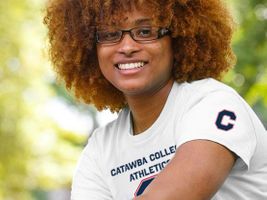As summer turned to fall last month along with the seasonal change of leaf color, you may have noticed some dazzling displays of yellow flowered asters along roadsides in our area including native ragweeds, Spanish needles, sneezeweeds, and sunflowers. In a few isolated roadsides in the Carolina piedmont that yellow floral display includes the federally endangered Schweinitz’s Sunflower.
To help restore Schweinitz’s Sunflower, 17 Catawba College students in the Departments of Biology and Environment and Sustainability participated in an important service learning activity to help preserve one of North Carolina’s rarest and most beautiful plants. The Schweinitz’s Sunflower is restricted only to the piedmont of North and South Carolina and has declined due habitat loss across the piedmont and a lack of natural disturbances such as fire and grazing by herbivores. Historically, Schweinitz’s Sunflower was likely present in open savannah like forests and grassy openings more common before fire suppression in the piedmont. As a service learning activity, members of Dr. Jay F. Bolin’s Field Botany course at Catawba College worked with the U.S. Fish and Wildlife Service (USFWS) and North Carolina Natural Heritage Program (NCNHP) to census all known populations of Schweinitz’s Sunflower in Rowan and Cabarrus counties.
Unfortunately all the known populations in the two county area do not occur in formally protected natural areas or parks but cling to road verges and power line or sewer right-of-ways. Roadsides and maintained right-of-ways provide suitable but precarious habitat where maintenance practices such as mowing simulate the effects of fire and herbivore grazing by controlling trees and shrubs which outcompete Schweinitz’s Sunflower for sunlight. Worryingly, each population is just one boom sprayer run of herbicide from being eliminated. Because of this threat, state agencies have posted “No Mow – No Spray” at many sites to warn contractors not to mow during the growing season or spray herbicide on the endangered plants.
Catawba College Field Botany students surveyed 15 sites for Schweinitz’s Sunflower during October 2017, aided by geographic information system (GIS) data provided by NCNHP which they loaded into Google Earth on their smartphones to pinpoint the populations in real time in the field. Most sites had been surveyed approximately five years ago, however one site had not been surveyed since 1991.
At each site, students carefully confirmed the identity the Schweinitz’s Sunflower relative to other similar native sunflower species, counted all stems present, and noted flowering or fruit production. Elizabeth Howard, a senior Biology and Environmental Science major from Mocksville, N.C., said, “The sunflower survey was a great experience to have because these are plants you don’t get to see every day and it feels good to be helping to conserve them.”
To the students’ dismay, one large Schweinitz’s Sunflower population in Cabarrus County near Concord was largely destroyed by a recent housing development. Fortunately, at that site a few flowering sunflowers were observed in a nearby sewer line right-of-way, which was noted in the comprehensive report. After the fieldwork was completed, the students summarized the data and submitted it to the NCNHP and USFWS. The data will be used as part the USFWS five-year review of the recovery plan for the endangered species.
Laura Fogo, Fish and Wildlife Biologist for the USFWS, was thrilled with the hard work of Catawba College students and remarked, “This is great teamwork to help recover an endangered species.”
Catawba students from the Departments of Biology and Environment and Sustainability participated in this service learning experience included Brooke Applebaum of Greensboro; Stephen Beaver of Salisbury; Caleb Berry of Lexington, S.C.; Chelsey Brown of Salisbury; Hunter Cheuvront of Baltimore, Md.; Stephen Daniels of Plainfield, N.J.; Joseph Dress of Moncks Corner, S.C.; William Eckard of Hildebran; Xavier Hare of Charlotte; Julieanna Herriven of New Bern; Kennadi Holt of Kernersville; Elizabeth Howard of Mocksville; Zachary Jones of Rockwell; Eleanor King of Matthews; Ashley Nazar of Raleigh; Frances Nyae of Salisbury; and August Weber of Georgetown, Texas.
